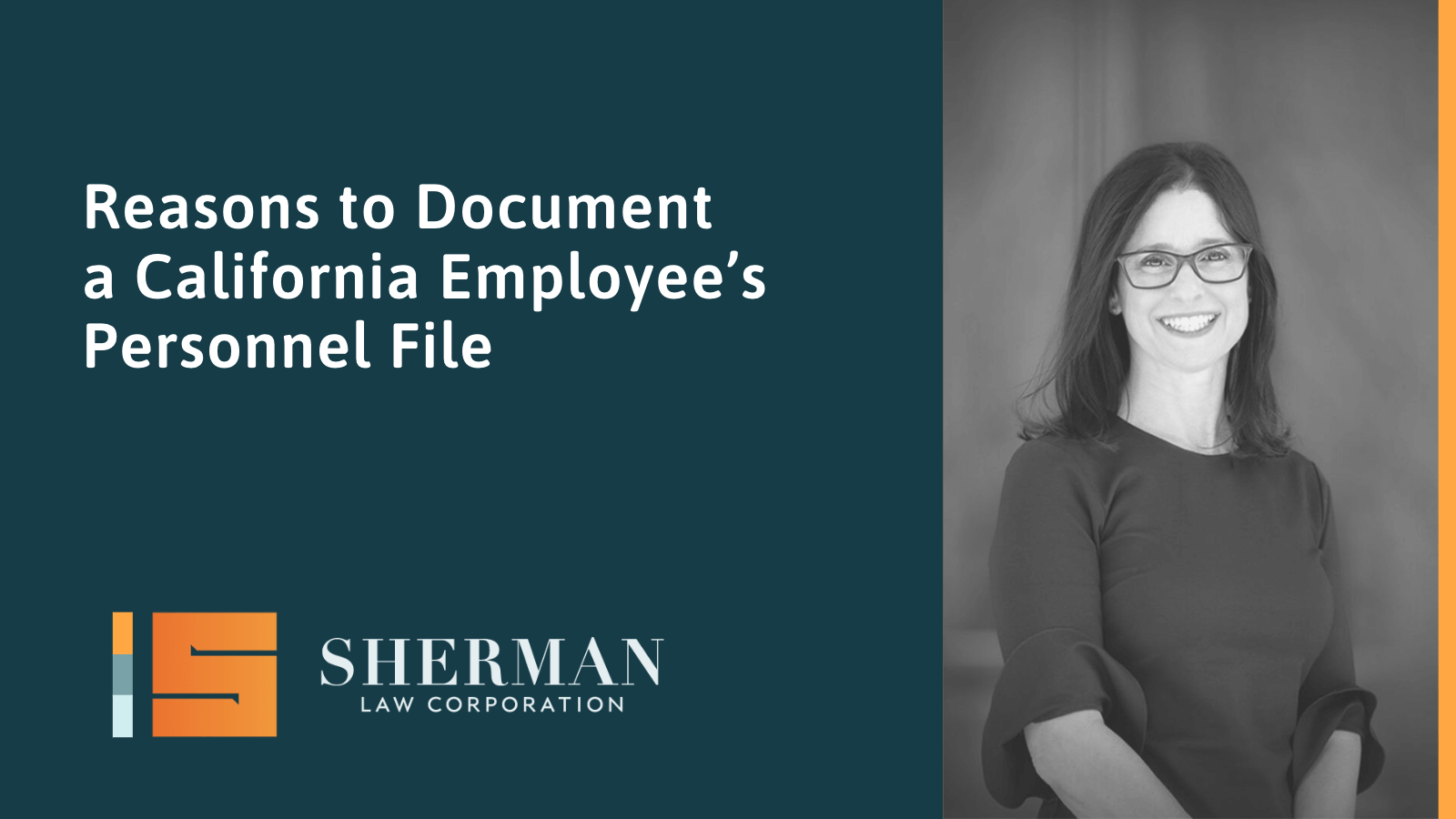
The most critical advice that I give to my employer clients is to “document the personnel file,” which is often met with an inquisitive look.
Documenting an employee’s personnel file is the easiest, least expensive way to create credibility for an employer and is what often saves an employer in defending claims.
- There is no better manner to convince a jury that the events the employer presents happened in the manner that it states by marking the documentation as “Exhibit A” and presenting it to the jury as written contemporaneously with the events.
- Contemporaneous documentation shows consistent treatment of employees.
- Written documentation often saves the day for an employer. For example, the California disability-related claims for failure to engage in the interactive process and failure to provide reasonable accommodations for disabilities, requires an employer to document the interactions the employer has with the employee as to reasonable accommodations to refute such claims.
- No documentation implies that there is little to no evidence to support critical decisions to discipline or terminate employment.
Employee Documentation Pitfalls in California
Just as one poorly worded impulsive “reply all” email or text will create employer liability, so will poor documentation. The biggest documentation pitfalls include:
- Self -serving, biased recitation of what transpired that contains personal attacks and subjective comments which will support employer bias
- Little or no evidence to support critical decisions to discipline and/or terminate employment.
- Ambiguous or unclear writings that do not provide the employee appropriate notice of the issues.
General Bullet point Guidelines
When should an employer document?
- Discipline or policy violations
- Coaching and counseling of any kind
- Performance Management
- Absences- Tardiness/Leave Early/leaves of absences of any kind
- Meal and rest break violations
- All communications with the employee about accommodations/assistance to perform his/her job
Complaints - When the employer says anything important
- When the discussion has relevance to the employment
- CONSTANTLY DOCUMENT, DOCUMENT, DOCUMENT!
What should an employer document?
- Legal Issues
- Medical leaves
- Disability
- Workers’ Compensation
- Harassment
- Discrimination
- Wage and Hour
- Retaliation
- Performance Issues
- Violation of Company policies
- Complaints
- All discussions that have relevance to the employment
Documentation Best Practices
- Create contemporaneous documents
- Include all details- dates, times, and full names
- Reference and/or attach evidence relied upon
- Bullet point documentation is prepared for a fact finder’s review– clear, objective, complete, consistent and fair
- If possible, obtain employee’s signature to verify discussion and goals
Documentation Deal Breakers
- Absolute expressions unless completely accurate, such as:
- Always
- Never
- Every time
- Invariably
- Do not record anything that you have not already communicated to the employee as the documentation is recording these communications
- Expressing personal opinions, accusations, or judgments
- Avoid generalities, conclusions, overstatements and exaggerations
- Saying or writing anything that could be construed as bias
Creating Bulletproof Documentation
Start off by Describing the Company’s expectations specifically referring to written documentation that defines these expectations including:
- Performance Standards/Job Description
- Handbook/Policies and procedures governing employment
- Writings setting forth requirements
Examples:
- The Company’s attendance policy states that your workday starts at 8 am…
- The Company meal break policy, a copy of which is attached hereto, requires that…
- Per the attached email, your supervisor directed that…
Describe the behavior/conduct/actions at issue that must change
- Focus on the behavior/conduct/actions and not the person who engaged in it
- Use objective criteria and words based on observations
- Avoid conclusory inflammatory language such as “your bullying” and, instead, detail what specific behavior/conduct/actions were observed and where possible, give detailed examples such as: “When you raise your voice, wag your finger, and slam the door behind you, your coworkers are afraid of you and do not want to work with you…”
- Describe the impact/effect on others and the business. For example, “several patients reported that they were so upset by how they were treated that they no longer want to interact with you.”
Examples:
- On Friday, September 10, 2023, you arrived at work at 8:15 am, without advance notice, or excuse…
- On the last zoom meeting, you interrupted me three times and stated “I don’t have to listen to this” when I was directing you to…
Provide the Employee’s Explanation as to his/her Behavior/Conduct/Actions at issue
- Shows fairness by allowing employee to be heard
- The explanation may show information you were not aware of
- If the employee has no explanation note it
- Locks in the employee to his or her story which may change down the line
- Provides opportunity for manager to help employee correct behavior/conduct/actions
Detail the action plan and goals going forward
- Detail what steps the employee is expected to take to improve/correct behavior/conduct/actions
- Detail what steps, if any, the manager or supervisor will take to help the employee achieve the results/goals
Set forth the Consequences if the Behavior/Conduct/Actions or Poor Performance does not Improve
- Include the magic words: “If the behavior/conduct/actions or poor performance continues, you may be subject to disciplinary action, up to and including, termination of employment.”
Include Timing of Expectations for Correcting Behavior or Performance
- Be realistic
- Consider expectations open
- If you include a time frame, you must follow up
- Detail what happens when you follow up
Follow-Up
- Critical to documentation and fairness
- Be carefulwith including exact time frame
- If you include time frame you must follow up
- State what will happen when you follow-up
- What part of the performance you will be reviewing
- Specific improvements that are expected
- Any additional training
- Further discipline
Documentation of the Separation of Employment
-
- Document reasons for separation. If a layoff, set forth the non-discriminatory factors considered in selecting positions/persons
- Document everything said at separation meeting, documents provided, demeanor of employee (i.e. if hostile, threatening etc.), employee’s response
- Be direct– state the employment ends on a specific date
- Recap reasons for separation
- Include dates of previous warnings
- Note opportunities, training, efforts made by both sides
Contact Lisa Sherman, California Employment Lawyer Today
Lisa Sherman knows that workplace disputes are more complicated than they appear at first glance. Her 26 years of experience defending employers throughout California has led her to think outside the box for cost-effective solutions – saving her clients from the frustration of lengthy and expensive lawsuits without results.
For more information on employment documentation in California, feel free to contact our office at 323-488-2087.




